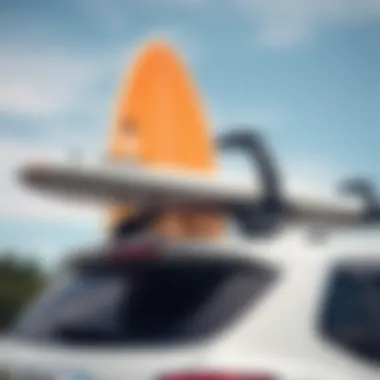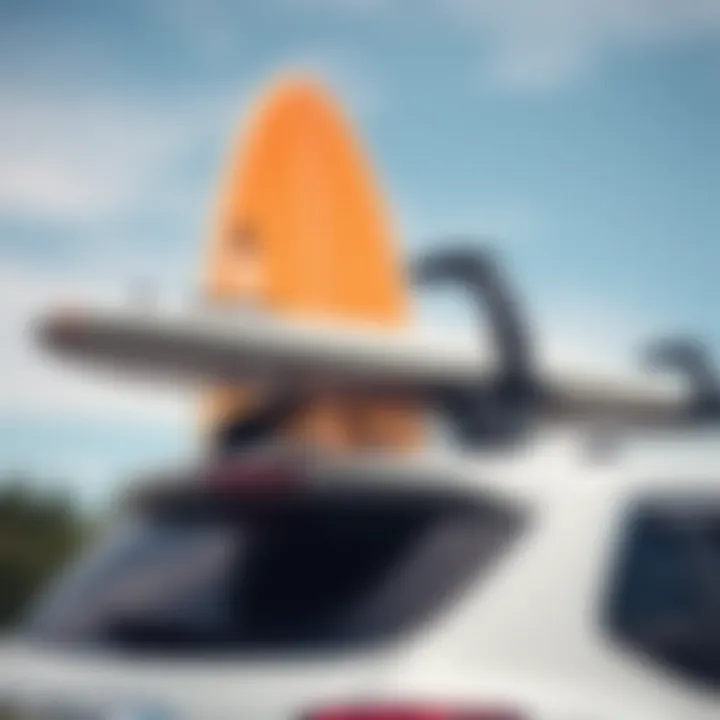Soft Roof Racks for Paddle Boards: A Complete Guide


Intro
Transporting your paddle board shouldn't feel like a wrestling match. If you've ever tried to haul your precious board atop your car, you might know the struggle of ensuring it stays put while on the open road. That's where soft roof racks come into play—a practical and lightweight solution for paddle board enthusiasts. These racks not only simplify the transportation process but also reduce the risk of damage to both your board and your vehicle.
This guide dives deep into the world of soft roof racks designed for paddle boards, shedding light on their functionality, advantages, and installation processes. Whether you are a novice just starting your paddling journey or an experienced surfer looking to upgrade your gear, this article is tailored to provide insights that resonate with everyone. We will break down different types of soft roof racks, compare them with hard racks, and highlight vital factors to consider when making your choice.
As we comb through various soft rack options, you will gain a clearer understanding of what works best for your unique needs. The objective is to equip you with knowledge not just to make an informed purchase but also to ensure safe and efficient transportation of your paddle board. So, let's hit the waves on this informational ride and ensure your gear gets there as safely and stylishly as you do.
Foreword to Soft Roof Racks
In recent years, the paddleboarding community has witnessed a significant rise in the popularity of soft roof racks. These innovative tools offer a practical solution for carrying paddle boards, merging convenience with functionality. While traditional hard racks have their own merits, soft roof racks present distinct advantages, particularly for enthusiasts who prefer flexibility and ease of use.
One of the key elements of soft roof racks is their lightweight design. Unlike cumbersome hard racks, which can add unnecessary weight to your vehicle, soft racks are crafted from materials that are both durable and easy to handle. This aspect alone makes them appealing to a wide range of users, from casual paddlers to those undertaking oceanic adventures. Secondly, the portability of soft racks is a major selling point. They can be easily stored away when not in use, adding to their appeal for travelers who might not want to invest in permanent installations.
Furthermore, the affordability of soft roof racks compared to traditional hard racks cannot be ignored. For those just starting out, or even seasoned paddlers looking to save a buck, the cost-effectiveness of a quality soft rack is enticing. The investment doesn’t just stop at the price tag; it also extends to the time saved during installation. Many soft racks are designed to be user-friendly, making setup a breeze. With minimal tools required and simple instructions, users find the installation process refreshing, adding to their overall experience.
However, while soft roof racks come with numerous benefits, there are a few considerations to keep in mind. Vehicle compatibility, load capacity, and user feedback are vital factors that will influence the purchasing decision. It's crucial for potential buyers to research and match their specific needs to what these racks can deliver.
In sum, the introduction of soft roof racks into the paddleboarding scene has transformed how enthusiasts transport their boards. Combining functionality, cost-effectiveness, and user-friendly designs, they’ve become a staple for many. As we delve deeper into the various aspects of these innovative racks, it becomes evident that they are more than just a passing trend; they are a pivotal element in enhancing the paddleboarding experience.
Understanding Paddle Boards
Understanding paddle boards is fundamental for anyone looking to integrate their paddle boarding experience with the right transportation solutions, such as soft roof racks. This section provides insights into different types of paddle boards, which ultimately informs your decision on the most suitable roof rack system to use.
When you grasp the various paddle board styles, you begin to understand how each influences not just your paddling experience, but also how effectively you can transport them using a soft roof rack. Knowing the distinctions can guide you towards making informed choices that ensure safety and usability while out on the water.
Types of Paddle Boards
Inflatable Paddle Boards
Inflatable paddle boards, often referred to as iSUPs, hold a significant place in the paddleboarding community. One of their most notable characteristics is their portability. Unlike traditional boards, which can take up a fair amount of space, inflatable boards deflate down to a compact size, allowing you to easily stow them in a car trunk or a closet. This feature is particularly beneficial for users who frequently travel or who have limited storage space.
A unique aspect of inflatable boards is their construction from durable materials that provide safety against punctures. Although they may lack the rigid feel of hard-shell models, iSUPs typically offer impressive stability. This versatility makes them a popular choice among casual enthusiasts and travelers alike, as they balance performance with convenience. However, they may require careful inflation and deflation processes, which could pose a challenge for some users.
Hard-Shell Paddle Boards
The hard-shell paddle boards are the heavyweights of the paddle boarding arena. What sets them apart is their rigidity and performance. These boards are often constructed from materials like fiberglass or epoxy, providing excellent speed and glide on the water. This makes them a favorite among serious paddlers and those looking to engage in activities like racing or wave surfing.
The durability of hard-shell boards does come with some considerations. They are less portable than their inflatable counterparts and may be cumbersome to transport without a sturdy roof rack. While they enhance maneuverability and offer a solid paddling surface, the weight and fragility can deter beginners or casual paddlers.
Hybrid Designs
Hybrid paddle boards bring together the best of both worlds, featuring the buoyancy of inflatable boards with some stability of hard-shell models. These boards often appeal to families or individuals who seek flexibility in their paddling experience. One key characteristic is their ability to support various paddling styles, which is essential for those who like to explore different environments - from serene lakes to tricky coastal waters.
Unique features of hybrids might include removable fins for easier transport and adjustments, opening up various paddling possibilities. While they have advantages like being lightweight, they may not perform as effectively in conditions requiring specialized designs, such as racing or rough waves. However, this versatility makes them a compelling option for new enthusiasts looking for a bit of everything.
Choosing the Right Paddle Board for Your Needs
Selecting the ideal paddle board aligns closely with your paddling aspirations and lifestyle needs. To make the right choice, think about several factors:
- Intended Use: Are you planning to paddle on lakes, rivers, or ocean waves?
- Weight Factors: Consider how much weight you want your board to support, including your gear.
- Experience Level: Beginners might prefer something stable and forgiving, like an inflatable, while experienced paddlers may seek performance-oriented hard-shell designs.
- Budget: Understand how much you are willing to invest in your paddle board, as prices can vary significantly.
Understanding these factors not only enriches your paddle boarding experience but also establishes a strong foundation for pairing your board with the right soft roof rack, ensuring safe transport to your destinations.
What Are Soft Roof Racks?
Soft roof racks are an integral part of the conversation when it comes to transporting paddle boards safely. They provide a flexible and user-friendly solution for avid paddlers who may not have access to traditional hard roof racks. In this section, we will dive into what soft roof racks are, how they work, and why they are an excellent choice for transporting paddle boards.
Definition and Mechanics
At its core, a soft roof rack is essentially a system designed to secure equipment on the roof of a vehicle without the need for permanent installation. These racks are typically comprised of soft straps and padded parts, making them adjustable to fit various vehicle shapes. Unlike hard racks that might require a hefty installation process or fixed mounts, soft roof racks can be set up in minutes. The mechanics behind them involve a belt or strap system that hugs the vehicle's roof securely, while the added padding prevents any damage to the vehicle itself or the paddle board.
Components of Soft Roof Racks
Diving deeper, let's explore the critical components that make up these versatile racks. Each component plays a role in ensuring safe transport and durability.
Belt System
The belt system is a foundational piece in the soft roof rack setup. This system employs heavy-duty belt straps made from tough materials like polyester or nylon, designed to withstand tension without stretching. A key characteristic that sets this belt system apart is its adaptability. Unlike hard racks that only fit certain types of vehicles, the ability to tighten and adjust the straps allows users to secure just about anything, from a paddle board to a kayak or a surfboard. This flexibility makes the belt system a popular choice among enthusiasts looking for practicality and ease. However, one must ensure that the belts are tightened adequately to avoid shifting during transport.
Padding and Protection
Next up, we have padding and protection features. The primary aim of this component is to provide a cushioning effect while also protecting the vehicle’s roof. Many soft roof racks come equipped with foam pads that sit between the strap and the vehicle, minimizing the risk of scratches or dents. The padding not only cushions the load but also helps in stabilizing the paddle board, which is essential during travel. The unique feature here is that these pads often have a textured surface to prevent slipping. An advantage is clear: they add an extra layer of security without complicating the setup process, thus making them a go-to choice for paddle board owners.
Anchor and Strap Systems


Lastly, no discussion of soft roof racks would be complete without mentioning the anchor and strap systems. These systems are vital for securing the load to the rack effectively. Typically, they feature anchor points that attach to the storm straps which work in tandem with the vehicle's roof. A distinctive element of this setup is its capacity to absorb shock, which can be particularly useful on bumpy roads. This feature speaks volumes about the rack's intended use, aimed at providing peace of mind for travelers. On the flip side, one might have concerns about the longevity of these materials when exposed to environmental elements like sunlight and rain, but many brands provide reliable materials that promise durability.
In Summary: Soft roof racks offer a convenient, flexible, and cost-effective means of transporting paddle boards, especially for those who prioritize convenience. From the adjustable belt systems that accommodate various vehicles to the protective cushioning that guards both the vehicle and paddle board, these racks are essential for any water-sport enthusiast.
For further reading, consider checking out sources like Wikipedia or Britannica for more insights.
Benefits of Soft Roof Racks for Paddle Boards
When one considers the world of paddle boarding, the transport of equipment is a critical aspect that should never take a back seat. Soft roof racks stand out as essential accessories for various reasons. They provide a perfect blend of convenience, affordability, and ease of use for paddle boarders ranging from novices to seasoned enthusiasts. Here, we delve into the specific advantages of opting for soft roof racks, shedding light on why they're becoming increasingly popular among paddlers.
Lightweight and Portable
One of the most significant advantages of soft roof racks is their light weight. Unlike traditional hard racks, soft roof racks are designed to be much lighter, making them a breeze to handle. This portability allows users to easily store or transport the racks without breaking a sweat. Pack them away in the trunk of your car or even your backpack on a road trip, and you’re ready to go in no time.
Moreover, the lightweight nature of soft racks translates to minimal impact on fuel economy. If you’re driving for hours to reach that secret paddle spot, knowing your load isn’t overly taxing on your vehicle’s fuel efficiency can be a comforting thought.
Affordability Compared to Hard Racks
When it comes to purchasing equipment, cost often plays a pivotal role in decision-making. Hard racks, while sturdy and reliable, tend to carry a heftier price tag. Soft roof racks, on the other hand, offer a budget-friendly alternative without compromising on functionality.
This affordability does not mean tolerating lower quality. Many soft racks are built from durable, weather-resistant materials that can withstand the environmental rigors associated with outdoor activities. This makes them an appealing choice for those who want reliable gear without going broke in the process.
“Why invest hundreds when you can achieve the same purpose with a soft rack at a fraction of the cost?”
In addition to the initial purchase price, soft racks often incur lower installation costs. They typically require no special tools and can be easily fitted onto most vehicle types, further enhancing their economic appeal.
Ease of Installation
The installation process for soft roof racks is undeniably simpler than that of their hard counterparts. There's no need for a degree in engineering to tackle this task. Just follow a few simple steps, and you’ll have your paddle boards secured in no time.
To illustrate this, here’s a basic rundown of the installation steps, which usually include:
- Positioning the racks on the roof: Place the soft racks in the correct positions based on the vehicle's design.
- Adjusting the straps: Many systems have adjustable straps that ensure a snug fit.
- Securing tightly: Double-check to ensure everything is secure and that no movement will occur during transport.
This straightforward approach not only saves time but also makes paddling ready to hit the water more accessible. You won’t spend half your day figuring out complicated instructions or wrestling with bulky gear.
Comparing Soft and Hard Roof Racks
When it comes to transporting paddle boards, one of the pivotal decisions you will face is choosing between soft and hard roof racks. Each type has its unique advantages and limitations, and understanding these nuances is essential for ensuring a safe and effective transport solution. Let’s dive in and unravel the differences that set these two categories apart while also navigating through their respective benefits, costs, and durability considerations.
Functional Differences
The first thing that takes the stage in comparing these two types is how they function. Soft roof racks consist mainly of padded straps and belts that attach to the vehicle's roof. They are designed with flexibility in mind, allowing them to conform to various vehicle shapes and sizes. On the other hand, hard roof racks are rigid structures often mounted permanently onto vehicles. These racks provide a stable and secure base for your paddle board but limit adaptability to different vehicle types.
- Soft Roof Racks:
- Hard Roof Racks:
- Lightweight and easy to install.
- Better for sporadic use or occasional trips.
- May not provide as much aerodynamic efficiency as hard racks.
- More stability during high-speed travel.
- Can often hold more weight without risk of bending.
- Designed for frequent use or for activities beyond just paddle boarding.
These functional differences mean that your choice will ultimately depend on how often you plan to use the rack and the type of vehicle you're working with. A frequent traveler may find the stability of a hard rack invaluable, while a casual paddler might prefer the convenience of a soft option.
Cost Analysis
Now, let's tackle the numbers. It’s no secret that budgets can influence our decisions, and when it comes to roof racks, soft racks often come out on top in the price department.
Typically, soft roof racks cost significantly less than their hard counterparts. For instance, a basic soft rack can be found for under a hundred dollars, whereas a robust hard rack system might splurge upwards of five hundred dollars or more, depending on the brand and features.
- Soft Roof Racks:
- Hard Roof Racks:
- Generally affordable; often ranges between $50 to $150.
- Lower initial investment and no additional installation fees.
- Higher cost, both for product and installation (if not self-installed).
- Long-term value may be higher for serious users.
While the initial cost of soft racks makes them appealing, keep in mind your long-term needs. For individuals who paddle board only during the summer months, saving a chunk on a soft rack might feel like a win, while avid paddlers might see a more significant return on investment with a hard rack.
Durability Considerations
Durability is another fundamental point in this comparison. Soft roof racks are designed to withstand moderate wear and tear, but they do have limits. Prolonged sun exposure and rough weather can be adversaries to the materials used in soft racks, potentially affecting their reliability long-term.
On the flip side, hard racks usually incorporate materials like aluminum or high-grade plastic that can stand up to elements and rough handling. Essentially, they provide a more solid longevity when well-maintained.
- Soft Roof Racks:
- Hard Roof Racks:
- Limited lifespan but can be effective if regularly checked for wear.
- Must be stored properly to prolong usage.
- Often last the lifetime of the vehicle
- Regular inspection recommended to ensure mounts are secure.
Ultimately, if you foresee heavy use or challenging conditions, you may want to invest in a hard rack for enhanced durability. However, for light use and flexibility, soft racks will fare decently, with proper care.


In summary, when weighing your options between soft and hard roof racks, consider the functional advantages, financial implications, and durability requirements aligned with your unique needs. Each choice carries its sets of pros and cons, so take a moment to assess what will serve you best in both the short and long term.
Key Factors to Consider When Choosing a Soft Roof Rack
Choosing the right soft roof rack is not merely a task of picking out any available option; it involves a careful consideration of various factors that can impact both the usability and the safety of transporting your paddle board. Understanding these key factors can save you from headaches down the road and ensure that your paddle board gets to your destination in one piece. Here’s a deep dive into what you need to keep in mind.
Compatibility with Vehicle Models
One of the first things to consider is whether the soft roof rack you’re eyeing is compatible with your vehicle model. Not all roofs are created equal. There are different styles, sizes, and shapes that will affect how a soft roof rack sits. Some models demand specific fittings or adjustments to secure the rack adequately, while others might accommodate a wider range of vehicles.
- Check Vehicle Recommendations: It’s always a good idea to check the manufacturer’s recommendations or guidelines for your specific vehicle model. This can include brands like Thule or Yakima that often provide detailed compatibility charts.
- Rail Systems: If your vehicle has factory rails, ensure the soft rack is designed to work with them, as some may need additional mounting kits.
- Consider Roof Shape: A vehicle's roof shape can significantly affect how easily a rack can be installed and how securely it holds a paddle board. Flat roofs are typically easier than rounded ones.
Load Capacity
Load capacity is another critical consideration when selecting a soft roof rack. Every paddle board has a specific weight, and it’s vital to ensure that your chosen rack can handle it, as well as any additional gear you might carry.
- Understand Weight Limits: Most soft roof racks have a specified load capacity. Look for this in product descriptions. Generally, a soft roof rack can hold between 100 to 200 pounds, but it’s always best to err on the side of caution. There’s no need to push limits; exceeding the capacity can lead to accidents.
- Board and Accessories: Don’t just factor in the paddle board's weight. Think about any additional gear, like paddles, life jackets, or other accessories. Add these weights together to get a comprehensive idea of how much you’ll be carrying.
User Reviews and Ratings
Before making a purchase, it's always wise to dive into user reviews and ratings. The experiences of previous buyers can offer insights that product descriptions often miss.
- Seek Out Diverse Opinions: It’s beneficial to read a variety of reviews to get a balanced view. Sometimes, even high-rated products can have specific drawbacks that may not work for you.
- Look for Common Themes: Are multiple users mentioning a certain issue, like difficulty in installation or instability during transport? Pay attention to recurring feedback, as it usually points to genuine concerns.
- Expert Opinions: Blogs and forums like Reddit or specialized sites may have discussions where experienced surfers share their preferences or disasters with certain brands. These can be gold mines of information.
Installation Process of Soft Roof Racks
The installation process of soft roof racks holds significant importance for paddle board enthusiasts looking to transport their boards safely and securely. Proper installation ensures that your paddle board remains stable during transit, which not only preserves the integrity of your board but also enhances your driving safety. A secure setup reduces the likelihood of accidental slips or shifts that can lead to damage or, worse yet, accidents on the road.
Before diving into the nitty-gritty of installation, it’s crucial to understand that each vehicle may require a slightly different approach. Recognizing your vehicle’s configuration and the specific components of your soft roof rack will lay a solid foundation for a smooth installation experience.
Preparation Steps
Prior to installation, preparation is key to ensuring everything goes off without a hitch. Here’s what you need to do:
- Gather Necessary Tools: Ensure you have all components of your soft roof rack handy. This includes the rack itself, any accompanying straps, and clamps. Knowing what you’re working with will make the task less daunting.
- Clean Your Vehicle’s Roof: Wipe down your car's roof to remove any dirt or debris. Grit can interfere with the stability of the soft rack and might leave scratches or marks on your vehicle's finish.
- Read the Instructions Thoroughly: It may sound obvious, but reading the manual or guide that comes with your soft roof rack can save you from headaches later on. Familiarize yourself with the parts and how they fit together.
- Check Compatibility: Make sure your soft rack is compatible with your specific vehicle model. This can prevent unnecessary struggles down the line.
- Plan Your Loading Sequence: Think ahead about how the paddle board will be loaded and secured. Planning this early will make you work more efficiently.
Overhead Installation Guide
Once you have everything set, it’s time to install the rack on your vehicle. Here are the steps:
- Position the Rack: Lay the soft rack on top of your vehicle’s roof, ensuring it’s centered and aligned with your roof's crossbars, if applicable.
- Fasten the Straps: Depending on the model, thread the straps through the door frames or attach them around your vehicle's roof pillars. It’s imperative to tighten them without excessive force that could lead to damage.
- Adjust for Stability: Before securing everything tightly, make sure the rack is level and straight. Adjust the positioning if needed.
- Secure All Components: Once positioned, firmly secure the straps and double-check that each component sits securely.
Final Adjustments and Safety Checks
With the soft roof rack attached, the final steps are crucial in ensuring that your paddle board is transported safely:
- Double-Check Tightness: Go through each strap again and confirm they’re tightened properly. A loose rack can result in the rest becoming a big hassle.
- Inspect the Rack: Look through the mirror while driving at low speeds to check if the rack remains stable and in place.
- Conduct a Test Drive: Before hitting the highway, take a short trip around the block. This allows you to spot any unusual vibrations or readjust if necessary.
These steps provide a structure for a successful installation process, allowing you to enjoy paddle boarding without the worry of securing your gear improperly. Safe travels!
How to Secure Your Paddle Board
When it comes to transporting your paddle board, the importance of securing it properly cannot be stressed enough. A solid transportation method not only ensures the board's safety but also protects other vehicles on the road. Whether you’re heading to the beach for a weekend getaway or just going for a quick afternoon session, understanding how to properly secure your paddle board is key.
Transporting a paddle board involves knowing the right techniques, using appropriate tools, and adhering to best practices. Plus, secure transportation can save you time and money on repairs or replacements of damaged gear. In this section, we’ll dive into effective securing techniques and how they can help you prevent damage during transport.
Securing Techniques
There are several methods to secure your paddle board to your vehicle, each with its pros and cons. Here are a few popular techniques you might consider:
- Strap Use: Using high-quality straps can ensure your board doesn't move around. Invest in wide straps that can distribute pressure evenly.
- Bow and Stern Lines: These lines link the board to the front and back of your vehicle, preventing any forward or backward motion. This method can be particularly useful for long trips.
- Inflatable Supports: Some soft roof racks come equipped with inflatable supports that can hold your board firm. This can be a game changer for those who don’t want to deal with traditional racks.
- Cross-Check Points: Make sure the straps overlap at the center of the paddle board. This creates a more balanced load and reduces potential shifting.
It’s worth mentioning that adjusting the tension of the straps is crucial. Too tight, and you risk damaging the board; too loose, and it might move during transport.
Preventing Damage During Transport
When you're out on the road, the last thing you want is to arrive at your destination only to find your paddle board scratched or dented. Here are some tips to prevent that:
- Use Padding: Gentle padding underneath the straps or any hard surfaces will minimize friction. Look for materials like foam or soft fabric to cushion your board.
- Check Conditions Regularly: During long trips, it's wise to take breaks and inspect how well everything is holding up. If you see signs of wear, make adjustments immediately.
- Secure Other Gear: It's not just the paddle board; if you have paddles, life vests, or any other equipment, make sure they’re secured too. Loose gear can slide and damage the board or get lost.
- Avoid Roof Damage: Be mindful of your vehicle’s roof as well. If your board is secured incorrectly, it could cause dents or paint chipping on your car.
Maintenance and Care for Soft Roof Racks
Maintaining and caring for your soft roof racks is crucial for not only the longevity of the equipment but also for ensuring the safety and security of your paddle board during transport. This aspect often gets overlooked, yet it plays an integral role in upholding the performance of the racks, enhancing your overall experience while you're out enjoying the water.
Proper care involves routine cleaning, inspecting for any signs of wear and tear, and storing them appropriately when not in use. Like any gear, soft roof racks need a bit of TLC to keep them in tip-top shape. Regular maintenance helps avoid unexpected surprises when you hit the road—nobody wants to pull over, only to find that their gear is falling apart.
In this section, we’ll dive into some of the more practical elements around cleaning and storage, giving you a rounded appreciation for how to keep your soft roof rack performing well.


Cleaning Tips
Keeping your soft roof racks clean is essential. The materials used in soft racks can accumulate dirt, salt, and grime from the elements, which can degrade both their appearance and functionality over time. Here are some useful tips to maintain their pristine condition:
- Rinse After Use: After every use, especially if you've been paddling near sandy beaches or salt water, give your rack a good rinse. It doesn’t take much—just a thorough spray with a hose will do wonders.
- Mild Soap Solution: For a deeper clean, use a mild soap solution with warm water. A soft cloth or sponge works best to wipe away dirt. Avoid abrasive cleaners or wire brushes; these can scratch and wear down the material.
- Dry Completely: After cleaning, it's vital to dry your racks completely before storing. Moisture can promote mold or mildew growth, which is never a good thing.
- Inspect Regularly: While you're cleaning, take a moment to inspect for any damaged areas or fraying straps. Early detection can save you from more expensive repairs down the line.
“Well-maintained gear not only looks better but performs better, ensuring you enjoy your time on the water.”
Storage Recommendations
Proper storage of your soft roof racks is just as important as cleaning. When the racks are not in use, following these guidelines can help prolong their life:
- Keep Them Dry: Store your racks in a cool, dry place. A garage or a storage box is preferable to outside environments where they can soak up moisture.
- Avoid Direct Sunlight: UV rays can degrade the components over time. If possible, place them in a shaded area or cover them to prevent sun exposure.
- Neat and Tidy: Make sure to store them neatly. Wrapping straps around the racks can prevent tangling, and keeping them in a dedicated bag can avoid unnecessary wear.
- Regularly Check Storage Conditions: Periodically examine the storage environment to ensure that extreme temperatures or humidity levels aren’t impacting your racks.
By following these maintenance and care guidelines, you can maximize the durability of your soft roof racks, promote safer transportation for your paddle board, and ultimately enhance your enjoyment of the sport.
Common Issues and Troubleshooting
When it comes to using soft roof racks for paddle boards, it's wise to consider the potential hiccups that may arise. Understanding these common issues is not just about prevention; it’s about ensuring that the whole paddling experience goes swimmingly. Whether you’re a seasoned pro or just starting, being aware of these troubleshooting aspects can save time and heartache, allowing you to hit the water with confidence.
Identifying Installation Errors
Installing a soft roof rack may seem like a walk in the park, but overlooking details can lead to serious mishaps. One common issue is improperly secured straps, which could easily loosen during transit. This might mean your board ends up shifting or worse, falling off the roof entirely. To avoid this, here are crucial steps for proper installation:
- Double-check the Tightness: After securing the straps, give them a good tug. If you can pull on them without a fight, you might need to tighten things up a bit.
- Use the Right Anchor Points: Ensure that the straps are anchored to designated points on your vehicle, avoiding places that might damage its structure or finish.
- Check for Friction: Sometimes, straps can slide around or rub against the roof. This not only risks scratching the paint but can also cause wear on the straps themselves. If you notice this risk, consider adding some padding or adjusting the strap path.
Moreover, inspect the overall alignment of the rack. A crooked setup can result in uneven weight distribution, leading to instability on the road. Never underestimate the importance of clear and careful installation; it’s one of the first steps to honoring your paddle board.
Addressing Wear and Tear
Just like any outdoor gear, soft roof racks aren’t immune to wear and tear. Over time, you might notice fraying straps or unstable padding. Addressing these factors ensures not only the longevity of your rack but also the safety of your paddle board. Here are a few points to consider:
- Routine Inspections: Before every outing, take a moment to inspect your rack. Look for signs of wear such as frayed edges or significant discoloration, which might indicate that it’s time for a replacement.
- Proper Storage: Storing your soft roof rack in a cool, dry place can help prolong its life. Heat and moisture can wreak havoc and prompt decay much sooner than expected.
- Replace When Necessary: It might be tempting to push things beyond their lifespan, but strapping a paddle board down with compromised equipment isn’t worth the risk. If parts are showing signs of failure, it’s better to replace them rather than gamble on their integrity.
Think of your soft roof rack as an extension of your paddling gear. The better you care for it, the more reliable it will be for your next outdoor adventure. Paying attention to these details not only avoids mishaps on the road but also empowers every enthusiast to transport their gear with peace of mind.
"An ounce of prevention is worth a pound of cure."
On one hand, being proactive in recognizing potential issues is beneficial; on the other, understanding how to troubleshoot these problems ensures that you’re always ready for whatever comes your way.
Innovations in Soft Roof Rack Technology
When it comes to transporting paddle boards, the advent of innovative soft roof rack technology has significantly changed the game. In an era where outdoor activities are at an all-time high, a reliable and user-friendly solution for transporting gear is paramount. This section will explore the groundbreaking advancements and future trends shaping the landscape of soft roof racks, catering specifically to the needs of surfers, instructors, and enthusiasts.
Advancements in Materials
The materials used in soft roof racks have come a long way, marking a significant evolution from earlier models. Modern soft roof racks utilize high-strength fabrics, such as ballistic nylon or cordura, which offer excellent durability and resistance against wear. These materials are not just lightweight; they also ensure that the rack can withstand harsh environmental conditions, like strong winds or heavy rainfall.
Additionally, many manufacturers are now embedding UV-resistant coatings in the fabric. This addresses one of the biggest pain points for outdoor gear: degradation from sun exposure. As a result, users no longer need to worry about their equipment becoming brittle or fading over time. This advancement not only heightens the lifespan but also enhances the aesthetic appeal of the racks.
Moreover, some soft roof racks feature specialized designs that help distribute weight more evenly across the surface of the vehicle’s roof. This is crucial as it minimizes stress on both the rack and the vehicle, thus reducing the likelihood of damage over time. Users can now feel secure knowing their paddle boards are being transported safely without compromising the integrity of their vehicle.
"The right materials can mean the difference between reaching your destination hassle-free or dealing with a tangled mess problem on the side of the road."
Future Trends
The future of soft roof racks appears to be heading towards even greater adaptability and sustainability. One exciting trend is the integration of smart technology into the design of these racks. Imagine a scenario where a soft roof rack could communicate with your vehicle, providing real-time data on load weight or even route optimization. While it may sound futuristic, some brands are already exploring apps that could assist users in secure loading techniques, enabling them to maximize efficiency during transportation.
Another significant trend is the ongoing emphasis on sustainability. As environmental concerns grow, manufacturers are increasingly focusing on eco-friendly materials and production methods. For instance, recycled plastics might become commonplace, minimizing waste and promoting a more sustainable lifecycle for outdoor gear. This not only appeals to environmentally conscious consumers but also sets a precedent for responsible manufacturing in the outdoor sporting industry.
Finally, customization is likely to be a game-changer. Future soft roof racks may come with modular features, allowing users to add or remove components based on their specific needs. This flexibility can cater to varying board sizes or shapes, ensuring that each user gets a tailored experience.
As we look ahead, innovations in soft roof rack technology will undoubtedly continue to enhance ease of use, safety, and environmental responsibility. Whether for a casual weekend trip or your next adventure to the waves, staying informed on these advancements will ensure that you are ready to transport your gear efficiently and sustainably.
Ending
In summary, this comprehensive guide has delved into the significance of soft roof racks for paddle boards, addressing their role in enhancing the overall paddling experience and ensuring safe transport. Understanding the nuances of these racks is vital, especially for surf enthusiasts, instructors, and travelers looking to explore waterways without the hassle of cumbersome equipment.
Recap of Key Points
Throughout the article, we explored crucial aspects of soft roof racks, including their lightweight design, cost-effectiveness compared to traditional hard racks, and ease of installation. The mechanics of these racks were discussed, highlighting components like belt systems, padding for protection, and various anchoring methods. Additionally, we illustrated the advantages inherent in choosing soft roof racks, which often hinge on portability and adaptability to a range of vehicle models.
Key considerations when selecting a soft roof rack were emphasized, such as load capacity, vehicle compatibility, and the importance of checking user reviews. Installation processes were broken down into clear steps, making it easier for users to ensure their paddle boards are safely secured for travel. Moreover, we looked at maintenance tips to extend the longevity of these racks, along with troubleshooting common issues that may arise during use.
Final Thoughts on Soft Roof Racks
As paddle boards become increasingly popular, the demand for effective transport solutions grows correspondingly. Soft roof racks present an appealing option for those wanting flexibility without sacrificing quality or safety. They bridge the gap between convenience, affordability, and the freedom to take your paddle board wherever your heart desires.
Looking ahead, innovations in materials and design within the soft roof rack industry suggest a future that offers even more effective and user-friendly options. Embracing these advancements can only enhance the experience of paddle boarders—hitting that perfect wave may just be a drive away. By investing in the right soft roof rack, enthusiasts can rest assured that their gear will arrive intact, allowing for thrilling adventures on the water. To dig deeper, consider exploring forums on sites like Reddit or professional reviews on platforms such as Britannica to connect with fellow paddlers and share insights on your journey.
"A paddle board is not just a piece of equipment; it's a gateway to adventures waiting beyond the horizon."
Ultimately, soft roof racks are not merely functional items but enrich the journey of paddle boarders, transforming how they engage with nature and explore new horizons.



